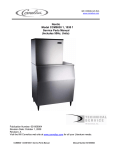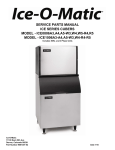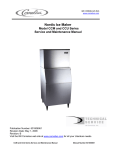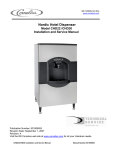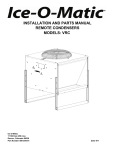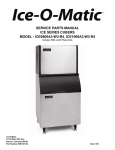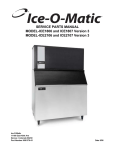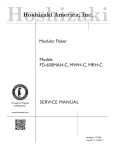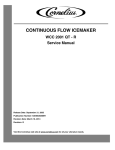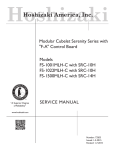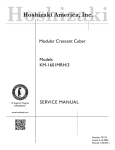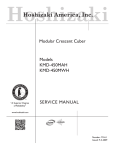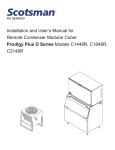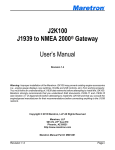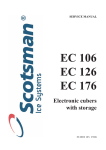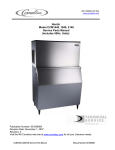Download Installation and Service Parts Manual Nordic Remote
Transcript
IMI CORNELIUS INC. www.cornelius.com Nordic Remote Condenser Model: RC Installation and Service Parts Manual Publication Number: 631806050 Revision Date: January 1, 2008 Revision: B Visit the IMI Cornelius web site at www.cornelius.com for all your Literature needs. RC Installation and Service Parts Manual Manual Number 631806050 Remote Condenser Forward How To Use This Manual Cornelius provides this manual as an aid to the service technician in installation and maintenance of remote condensers. Do not attempt to perform installation, start-up or maintenance unless you have read and fully understand this manual. If, at any time, you encounter conditions that are not addressed in this manual, call or E-mail the Cornelius Service Department: E-Mail: [email protected] Telephone Number 800-238-3600 All Departments Any Service communication must include: • Model Number • Serial Number • A detailed explanation of the problem Keep this manual for future reference. Cornelius icemakers and dispensers are not approved for outdoor installation. WARNING: Always disconnect electrical power and shut off water supply whenever maintenance or repairs are performed on the ice machine and related equipment. CAUTION: Always wear protective eyewear whenever maintenance or repairs are performed on the ice machine and related equipment. Page i Remote Condenser Table of Contents Forward Page i Table of Contents Page ii Freight Claim Procedure Page iii General Information Page 1 Installation Guidelines Page 2 Remote Refrigeration System Page 4 Component Description Page 5 Installation Page 6 Service Parts Page 10 Page ii Remote Condenser Freight Claim Procedure Freight Claims Important! Inspect Promptly This merchandise has been carefully inspected and packed in accordance with the carrier’s packing specifications. Responsibility for safe delivery has been assumed by the carrier. If loss or damage occurs, you as the consignee must file a claim with the carrier and hold the container for carrier’s inspection. Visible Loss or Damage Any external evidence of loss or damage must be fully described and noted on your freight bill or express receipt and signed by the carrier’s agent. The claim should be filed on a form available from the carrier. Concealed Loss or Damage If loss or damage does not appear until merchandise has been unpacked, make a written request for inspection by the carrier within 15 days of the delivery date. Then file a claim on a form from the carrier. File Claim Without Delay Do Not Return Damaged Merchandise to Cornelius. Page iii Remote Condenser General Information Condenser Dimensions (Inches) Model Length Width Height Compatible With: RC05001 29.18 29.50 38.90 CCM0500R RC06002 29.18 29.50 38.90 CCM0630R RC08002 29.18 29.50 38.90 CCM0830R RC08002 29.18 29.50 38.90 CCM1030R RC14002C 29.18 29.50 38.90 CCM1448R*1 RC14002C 29.18 29.50 38.90 CCM1530R*1 RC21002C 37.78 29.50 38.76 CCM1848R*1 RC21002C 37.78 29.50 38.76 CCM2148R*1 Note: *Includes 60 Hz. Single Phase, Three Phase and 50 Hz. Note the warning symbol where it appears in this manual. It is an alert for important safety information on a hazard that might cause serious injury. Keep this manual for future reference. Verify the ice machine is compatible with the remote condenser. Some ice machines and some remote condensers may or may not have a Mixing Valve (Head Master). Only one valve is required per system. Kits are available to modify the remote condenser for compatibility. For more information contact your Cornelius Distributor. Page 1 Remote Condenser General Information Introduction Cornelius Remote Condenser Systems are comprised of three components. The pre-charged remote condenser, the pre-charged ice maker and the pre-charged line set. The pre-charged line sets are available in 25, 40, 45, 60 or 75 foot line set lengths. The 60 foot line set will require adding an additional 16 ounces of refrigerant to the system. The 75 foot line set will require adding an additional 28 ounces of refrigerant to the system. Normal installation of the ice maker should be followed. Reference the installation instructions included with the ice maker. In any installation, the pre-charged line sets, consisting of a liquid line (3/8” dia.) and a discharge line (1/2” dia.) are used as a one time initial charge type installation. Once the sealed couplings are connected and the internal seal is broken, the lines cannot be disconnected without losing the refrigerant charge. They are, however, reusable and when the couplers are removed and reconnected, the complete refrigeration system must be evacuated and re-charged with the proper amount of refrigerant. Reference the ice maker data plate or ice maker service manual for proper refrigerant charge. General Description The remote condenser should not be used in areas where sufficient airflow is not available in the area the ice maker is being installed or the heat being rejected by the condenser coil will be undesirable. The condenser coil should not be exposed to temperatures below -20°F (-29°C) or above 120°F (49°C). The remote condenser functions as a normal refrigeration system until the temperature at the condenser coil drops below 70°F. At this time the mixing valve will begin to bypass enough hot gas from the discharge line directly into the receiver to keep the liquid line feeding the expansion valve at a steady pressure. The amount of gas bypassed will depend on the temperature at the condenser coil (the colder the temperature at the condenser coil, the more gas will bypass and the tubing between the mixing valve and receiver will become warmer). For the complete explanation of this valve, refer to the schematic on page 6 of this manual. VRC Condenser Condenser Location When choosing a location for the remote condenser, reference the following guidelines: 1. Choose a location that is protected from extremes of dirt, dust, rain, sun and prevailing winds. 2. Vertical air discharge mounting of the condenser is required. 3. Condenser should be mounted higher than the ice machine. 4. Condenser must be level. 5. Condenser should not be exposed to temperatures below -20°F or above 120°F. 6. Installation must meet all local and national building, plumbing and electrical codes. Airflow Page 2 Remote Condenser General Information The remote condensers incorporate the mixing valve in the condenser. This configuration allows up to a 100 foot calculated remote line set run. Reference the diagram below to calculate the maximum 100 foot line set run. Limitations for new remote machines that have the mixing valve mounted in the condenser. Maximum Rise is 35 feet. Maximum Drop is 15 feet. Maximum equivalent run is 100 feet. Formula for figuring maximum equivalent run is as follows: Rise x 1.7 + Drop x 6.6 + horizontal run = equivalent run. Examples: 35 ft. rise x 1.7 + 40 ft. horizontal = 99.5 equivalent feet line run 35 ft. rise 40 ft. horizontal Verify the ice machine is compatible with the remote condenser. Some ice machines and some remote condensers may or may not have a Mixing Valve (Head Master). Only one valve is required per system. Kits are available to modify the remote condenser for compatibility. For more information contact your Cornelius Distributor. 34 ft. horizontal 10 ft. drop 10 ft. drop x 6.6 + 34 ft horizontal = 100 equivalent feet line run Page 3 Remote Condenser Remote Refrigeration System The Remote Refrigeration System is shown in the above diagram. During the freezing cycle, high temperature and high pressure liquid refrigerant is directed from the condenser through a mixing valve, receiver, liquid line solenoid heat exchanger and a filter drier. The expansion valve meters refrigerant to the coils on the back of the evaporator. In low ambient conditions (below 70°F air temperature at the condenser) the mixing valve opens to mix discharge gas with liquid returning from the condenser, in the receiver, to maintain discharge and liquid line pressures. The low temperature and pressure refrigerant leaving the evaporator is directed through the suction line heat exchanger and is returned to the compressor. There it is compressed to a high temperature and high pressure gas. It is then directed to a condenser to be converted again to a high pressure and high pressure liquid. During the harvest cycle, the hot gas solenoid valve (normally closed during the freeze cycle), opens and directs the high temperature gas leaving the compressor into the evaporator. Once the evaporator has reached approximately 40°F, the harvest motor overcomes the capillary attraction of the ice and the evaporator releases the ice. At the end of the harvest cycle, the hot gas solenoid valve closes and another freeze cycle begins. During the off cycle, the liquid line solenoid valve closes and the system will pump down to 10-20 psi to prevent refrigerant migration to the roof top condenser. Page 4 Remote Condenser Component Description Mixing Valve (Headmaster, Low Ambient Control Valve) This valve serves as the head pressure regulating valve. It contains a pre-determined charge of nitrogen in the valve bellows. When the temperature at the condenser is above 70°F (21°C), the refrigerant flow from the compressor is directed by the mixing valve through the condenser and into the receiver. When the temperature at the condenser drops below 70°F (21°C), the pressure in the bellows of the mixing valve becomes greater than the pressure of the liquid refrigerant coming from the condenser. This change allows the valve to partially restrict the flow of refrigerant leaving the condenser and allows discharge gas to by-pass the condenser and flow directly into the receiver, mixing with the liquid refrigerant from the condenser. The amount of discharge gas that bypasses the condenser increases as the ambient temperature decreases. This action of the mixing valve allows the discharge pressure to be maintained at approximately 240 psi (16.5 bar) during low ambient conditions. If the refrigerant system is undercharged and the ambient temperature is below 70°F (21°C), the mixing valve will not work properly. The mixing valve will allow too much refrigerant to bypass the condenser. Receiver The quantity of liquid refrigerant in the receiver will vary with the temperature at the condenser coil. Liquid Line Solenoid and Pump Down Low Pressure Control When the bin is full or the ON-OFF switch is turned to the OFF position, the liquid line solenoid valve closes and the system begins to pump down. When the low pressure reaches 10-20 psi, the pump down low pressure control opens and the contactor shuts the machine off. As the ice is removed from the bin or the ON-OFF switch is turned to the ON position, the liquid line solenoid valve opens and the high side and low side pressures begin to equalize. When the low side pressure reaches 50-75 psi, the pump down low pressure control closes and the machine begins a freeze cycle. When the machine is off for extended periods of time (either a full bin or the ON-OFF switch in the OFF position), it will pump down approximately once every hour. This is due to the equalization of pressures during the off cycle resetting the pump down low pressure control. It is a normal function of the refrigeration system. Condenser Fan Motor The condenser fan motor is a single speed, permanent split capacitor motor and should be wired according to the wiring diagram. The motor is permanently lubricated for long service life. Page 5 Remote Condenser Installation Electrical Connections 1. The icemaker and the remote condenser both require a solid earth ground that meets National, State and Local Codes. 2. Reference the ice machine and condenser date plate for current requirements to determine wire size for electrical hook up. 3. Make sure the supply voltage is the same as the rated voltage shown on the nameplate. 4. Reference wiring diagram below for proper connections. INSTALLATION NOTICE: THESE REMOTE CONDENSERS MAY ONLY BE USED WITH COMPATIBLE CORNELIUS ICE MAKERS Electrical shock and/or injury from moving parts inside this machine can cause serious injury. Disconnect electrical supply voltage to the machine and condenser prior to performing any adjustments or repairs. Page 6 Remote Condenser Installation Support Leg Installation 1. After removal of the packaging and fasteners, lift the condenser assembly off of the skid. 2. Locate the legs and leg braces attached to the condenser assembly. Cut the wire ties and separate the legs from the condenser. 3. Locate the fasteners that are in a bag attached to the condenser top panel. 4. Assemble the legs and braces to the condenser as shown below. Page 7 Remote Condenser Installation Page 8 Remote Condenser Installation Proper Tubing Routing When installing the discharge and liquid lines from the remote condenser to the icemaker, please use the following guidelines: 1. The remote condenser (#2) should always be installed above the icemaker (#4) as shown with a vertical air flow on page 10. 2. All excess tubing (#1) should be routed inside the building and coiled in a vertical spiral as shown (3#) on page 10, to prevent oil trapping in the lines. Any tubing run outside should be insulated to protect it from surrounding ambient conditions. Tubing should follow straight line routing whenever possible. The lowest spot in the tubing run should be the connection at the rear of the icemaker. Both the discharge line and liquid line quick connect couplers are supplied with a Schrader Valve on one end of the line set. The Schrader Valve end should be connected to the remote condenser on both the discharge and liquid line for access to pressure readings at the condenser as shown (#5) above. When attaching the quick connect couplers (#6), always lubricate the couplers with refrigerant oil. The couplers should be tightened until snug, then tightened another quarter (1/4) of a turn. Always leak check the quick connect couplers after installation has been made. Page 9 Remote Condenser Item Description Service Parts CCM0530 CCM0630 CCM0830 CCM1030 CCM1448R1 CCM1530R1 CCM1848R1 CCM2148R1 RC05001 RC06002 RC08002 VRC2661 VRC5061 1 Fan Guard 620204581 620204581 620204581 620204581 620204843 2 Top Panel 620204369 620204369 620204369 620204369 620204838 3 ¼-20 x 1/2 Screw 620204436 620204436 620204436 620204436 620204436 4 Fan Blade 620204580 620204580 620204580 620204580 620204844 5 Fan Motor 620204647 620204646 620204646 620204646 620204846 6 ¼-20 x ¾ Cap Screw 620204425 620204425 620204425 620204425 620204425 7 Flat Washer 620204426 620204426 620204426 620204426 620204426 8 Flanged Lock Nut 620204448 620204448 620204448 620204448 620204448 9 ¼-20 x 1/2 Screw 620204436 620204436 620204436 620204436 620204436 10 Rear Panel 620204371 620204371 620204371 620204371 620204371 11 Brace 620204373 620204373 620204373 620204373 620204840 12 Leg 620204374 620204374 620204374 620204374 620204374 13 Leg Brace 620204375 620204375 620204375 620204375 620204841 14 T-Nut-Shipping Only N/A N/A N/A N/A N/A 15 Brace 620204373 620204373 620204373 620204373 620204840 16 Cover Panel 620204377 620204377 N/A N/A N/A 17 Center Panel 620204372 620204372 620204372 620204372 620204839 18 Front Panel 620204370 620204370 620204370 620204370 620204370 19 Motor Brace 620204379 620204379 620204379 620204379 620204842 20 Motor Brace Support 620204378 620204378 620204378 620204378 620204378 21 Junction Box Cover 620204376 620204376 620204376 620204376 620204376 22 Mixing Valve 620204625 620204625 620204625 620204625 620204625 23 Condenser 620204600 620204600 620204600 620204837 620204845 24 Filter 620204626 620204626 620204626 620204626 620204626 25 1/2 Coupling 620204527 620204527 620204527 620204527 620204527 26 3/8 Coupling 620204526 620204526 620204526 620204526 620204526 27 Filter 620204627 620204627 620204627 620204627 620204627 Page 10 Remote Condenser Service Parts Page 11















